24 September 2022
After breakfast in Kokand, we face the short drive and possibly grueling border crossings from Uzbekistan into the fourth of the Stans: Tajikistan.
We drive over miles of bumpy roads passing farmlands and arid steppe. Mountains are always within sight although seen through haze and dust. We will cross the Uzbek/Tajik international border, drive for miles along a semi-hostile and burned-out Kyrgyzstan border, (engaged in an undeclared cold war and have the worst bilateral relations in Central Asia), and see even more mountainous and beautiful country than we have left behind. There is no doubt that “warrior soldiers” could fight in these mountains forever.
The Uzbekistan/Tajikistan border’s immigration and customs formalities were surprisingly slow. Thankfully there were only nine of us. Uzbeks not as friendly with goodbyes as was their welcome, I believe the fault was with an incredibly slow computer system. Possible all communications are routed through Russian servers? Check of Visa, our little slip of paper indicating where we slept last night, photo and Passport stamp before we move on to the next check point. There we are quickly processed through Tajikistan Immigration with a stamp in the Passport. Our new Tajik driver and Tajik guide await in a somewhat smaller, less comfortable van. White of course. The guide’s T-shirt says it all “Tajikistan, land of friendship.”
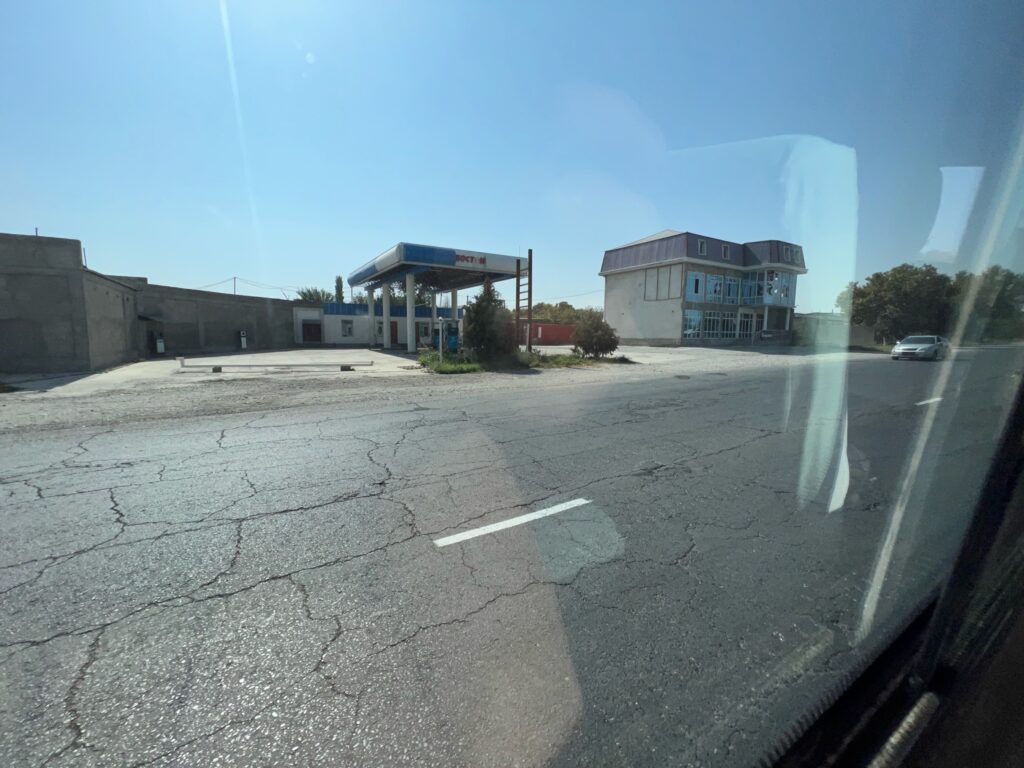
Conflict/War between Tajikistan and Kyrgyzstan has involved serious skirmishes along the borders, each blaming the other. Arguing continues over a border dating back to early Russian maps. A small isolated enclave of about 30k people is cut off from Tajikistan by a narrow strip of Kyrgyzstan land. The dispute probably could be solved with a long bridge.
We drive several miles parallel to the Kyrgyzstan border. Literally, the chicken crosses the road to eat Tajikistan bugs. I see homes and countless petrol stations and casinos burned out. Gas was cheaper in Kyrgyzstan and casinos allowed so Tajiks just made a left turn. As the common border turned inland, business and normal Tajik life returned.
Tajikistan is the home of the Tajik people who populated lands not only here but in Afghanistan and Uzbekistan. Ancient cultures date back more than 12,000 years. Many cultures and faiths from Buddhist and Christians to Zoroastrian and Islamist traveled these lands. Empires ranged from the Mongols and Timurids to Huns and Soviets. Independence, when the USSR disintegrated, was achieved in September 1991 followed by 5 years of vicious tribal civil war and the loss of thousands of people who fled the country. Though a constitutional republic, there continues much criticism with such descriptive terms as “authoritarian, corruption, and persecution.”
The land of the Tajik, the Crown, is 95% Sunni and 3% Shia, 93% mountains, mostly agricultural growing cotton and grapes, an exporter of hydropower, and landlocked. I am surrounded by the countries of China, Uzbekistan, Kyrgyzstan and Afghanistan.
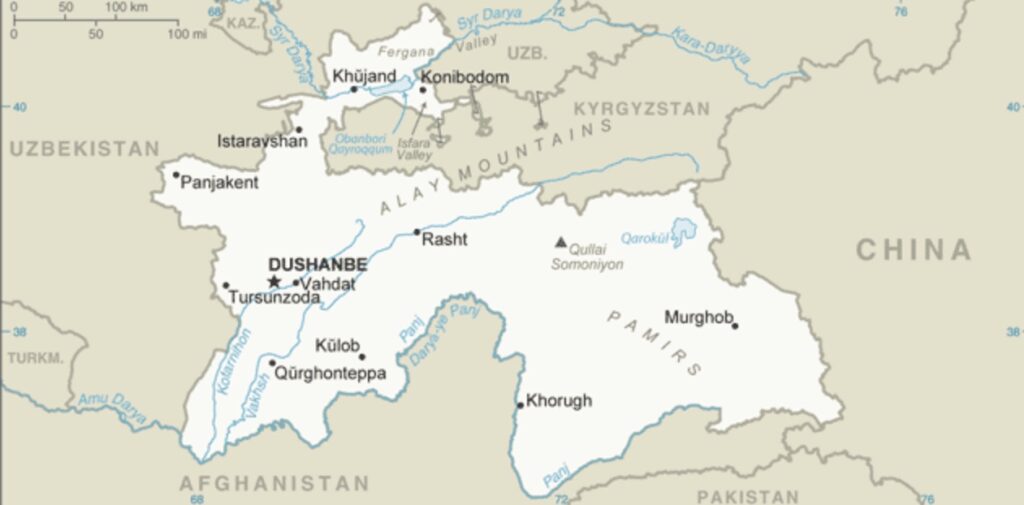
Over 84% of the population is Tajik, 14% Uzbek. The official language is Tajik though Russian is unofficial. Smallest of the Five Stans, an estimated 9.1 million live here with a density of 125 per square mile. The economy is fragile with a GDP of $824 per capita; most people live on $1.25 a day! Corruption is blamed for much of these ills; drug trafficking is common, mostly from across the Afghan border. Another problem the economy faces is that 47% of their GDP comes from immigrant remittances, mostly from relatives working in Russia. (Over a million Tajiks work in Russia. More than 120,000 have Russian citizenship so could be conscripted for Putin’s War.) There are just 420 miles of railroad, 26 airports of which 18 are paved, few natural resources. Tajikistan faces an uphill battle to compete with their neighbors in Central Asia. I have faith in them that they will meet the challenge.
The earliest recorded history dates to about 5000 BC. The ancient culture of Sarazm dates to approximately 3900 BC. It was temporarily under the control of the Tibetan Empire and Chinese from 650–680, the Samanid Empire 819-999, then Genghis Khan invaded in the 13th century and less than a century later the Mongol Empire fell. Tamerlane and his Timurid dynasty took control in the 14th century. Modern Tajikistan then fell under the rules of the Khanates to be replaced eventually in the 19th century by the Russian Empire. It has been a tough slog for the Tajiks.
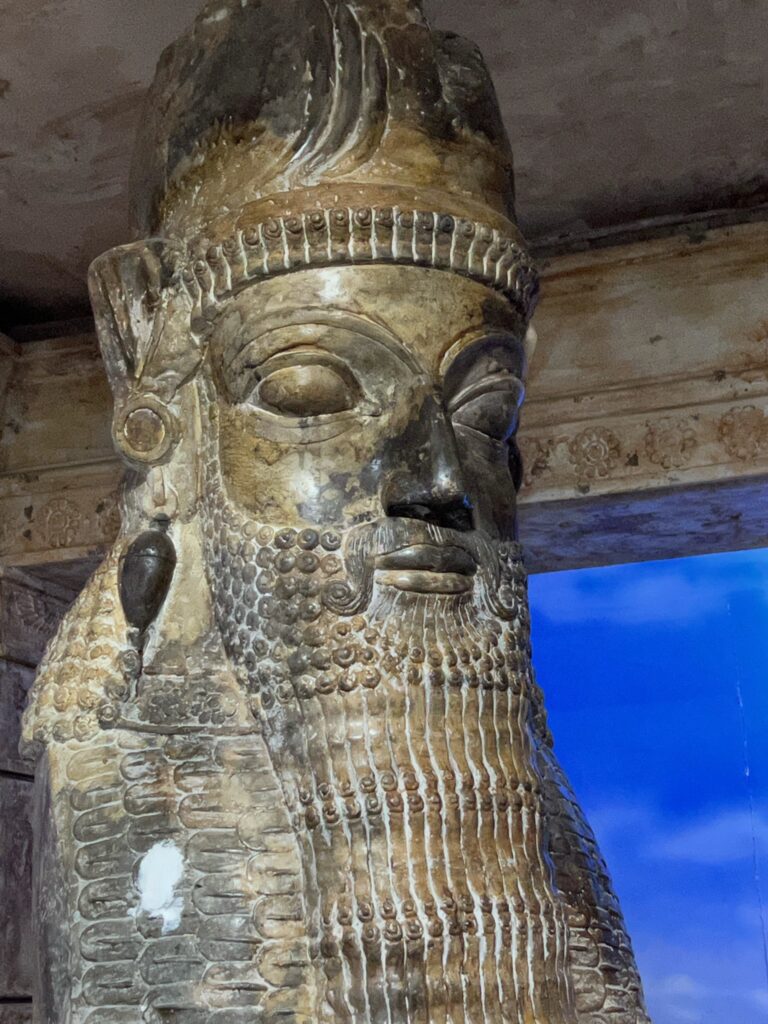
Tajikistan, in 2009, officially recognized Sunni Islam as the official religion with a 97% Muslim population. Yet, it considers itself a secular state. There are some leaders who feel minority religious groups undermine national unity and fear their involvement in government. By law, religious communities must register at the State Committee on Religious Affairs and there are restrictions as to freedoms to practice. As of 2016, as part of an anti-radicalization campaign, police in one southwestern region reportedly shaved off beards and shut down 160 shops selling the hijab, restricting university women from wearing them. According to a BBC report, “Shaving beards and discouraging women from wearing hijab is part of a government campaign targeting trends that are deemed “alien and inconsistent with Tajik culture”, and “to preserve secular traditions.” Clearly, religion is an issue to evolve and resolve in Tajikistan.
Tajikistan is trying to modernize by building the highest dam in the world but at the same time awarding mothers for having more children. Attempts to democratize are made but they have had only three presidents since independence in 1991; two of them were communist and run out of office. The current President Rahmon was de facto head of state from November 1992 and elected President in November 1994. His smiling, confident countenance can be seen in huge posters all over every vertical surface about the country. Rousing quotes inspire his citizens. With the median age being 22, most citizens know no other leader. Not exactly a “dear leader” but an endeared one.
An interesting rule of their parliamentary system is that every ex-president becomes a member of parliament, joining the elected representatives. The first two were communist and protests forced them from office but they still had seats in parliament. Tajikistan is also including women in parliament and one unsuccessfully ran for president.
Despite poverty, Tajikistan has an estimated 99% literacy rate even though school enrollment is significantly below the world average. Some say Tajiks leave because there is so little demand for higher education or skills. Russia makes up for this by attracting the educated and skilled. An additional one million semi-skilled Tajiks work in Russia. As is often the case for immigrants, many Tajiks end up with the crap-jobs that Russians don’t want to do. And because most do not drink, Tajiks are often preferred over the vodka-laden Russian (their description, not mine). Tajik culture stresses families supporting each other so wages earned in Russia are important to the Tajikistan economy.
Public spending on education is about 4.1% of GDP. UN reported that this level was “severely inadequate.” This encouraged me to look up that of the United States, the wealthiest industrialized country: 4.96% in 2014, just slightly more than “severely inadequate.”

I will be seeing just a small part of Tajikistan; my 48 hours will be spent visiting a small neck of land in the Sughd Province. I will be lodging at the Grand Khujand in the principal city of Khujand which snuggles between the borders of Uzbekistan and Kyrgyzstan along the Syr Darya River.
Just steps from the hotel is the Historical Museum of Sughd Region, housed in the reconstructed Khujand Fortress. It contains a nice collection of artifacts and displays documenting the history of this region. The fortress stands next to the pleasant Khujand Gardens. Within the gardens are beautiful wood carved pergolas, and the mausoleum and home/museum of Kamoli Khujand. Kamoli Khujandi was a Persian Sufi poet of the 14th century. He was born in Khujand and considered among the great romantic poets of his century. He died in 1400 and is buried in Iran.
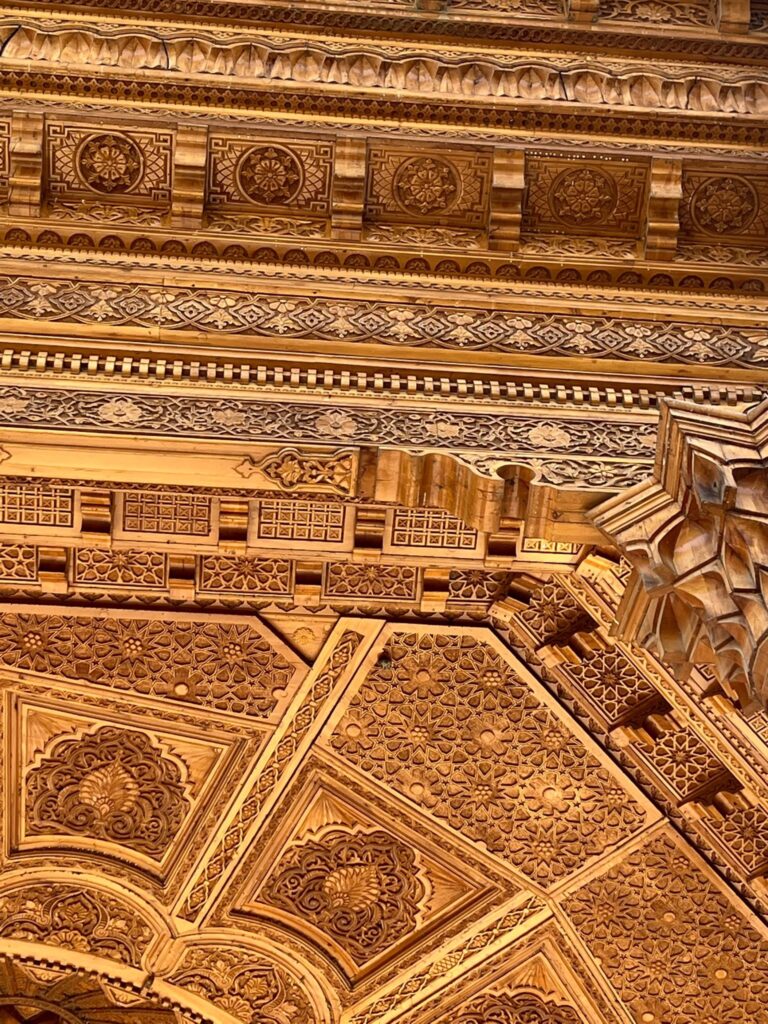
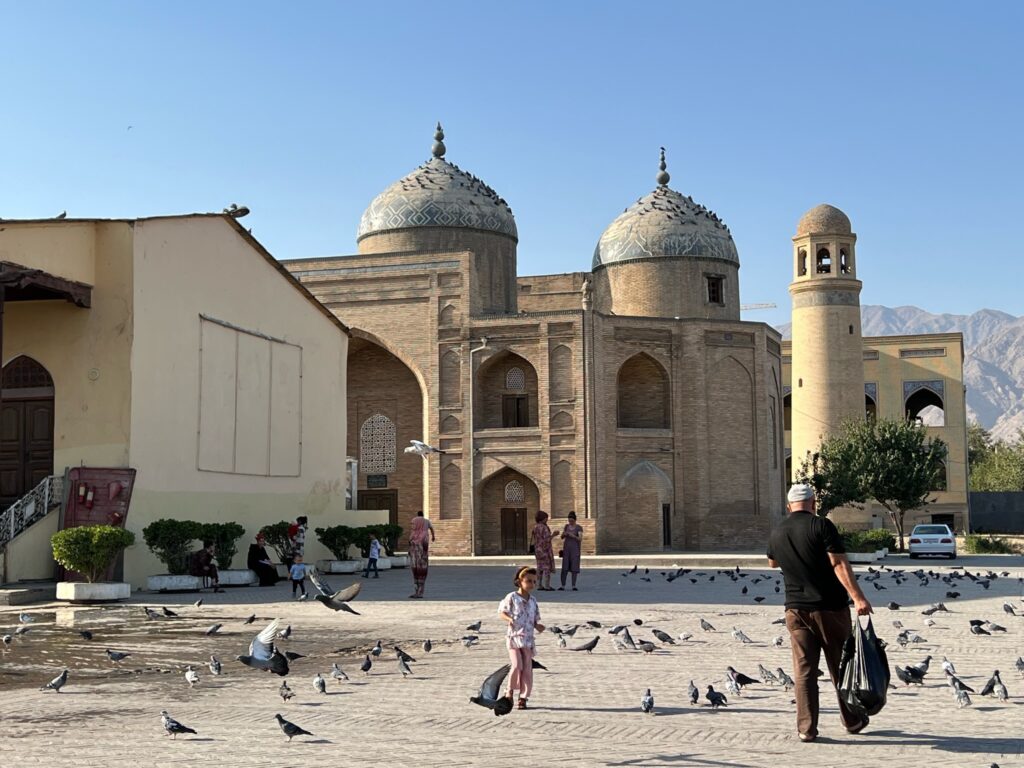
The Mosque and Mausoleum of Sheik Muslihiddin are located in a large public square. The double-domed mausoleum is one of the most sacred of sites to Muslims. It is named after the city’s famous 12th-century poet and ruler, Muslihiddin Khujandi. He was revered as a holy man capable of performing miracles and when he died, he was buried outside the city but later his ashes were moved into this mausoleum which is built over his tomb. The adjacent mosque has a 65-foot 19th century brick minaret. Inside the mosque, walls are white and unadorned under a magnificent cupola. The entire square is pidgeon-plagued and faces the Panjshanbe Bozor.
On the east side of the square is a lively farmer’s market and beneath a huge roof is the Panjshanbe Bozor/Bazaar, a gigantic one-stop-shop mall but with a whole lot more color and culture. Local delicacies, fresh products, dried fruits and nuts, spices and melons abound. Don’t find what you want? Look harder, it has to be there somewhere. For the first time I saw butchers who had wrapped their cuts of meat with cellophane to protect it from the elements, i.e. flies.

On the south side of the square is a small park and a World War 2 Memorial. More than a quarter million Tajiks were conscripted into the Russian Army beginning in 1939. That is a lot considering their small population. It is estimated between 60,000 and 120,000 of its 1.5 million citizens were killed during that war. Most Tajiks remember this history and are not eager to repeat it by supporting Putin’s current debacle.
It has been a long day and a hot one. It is over 90° under a relentless sun. Like Dorothy’s wicked witch, “I’m melting.” This is a Muslim country, city, hotel, and life. Cold juices abound, water in bottles available. It is a cold beer I seek. A Stella, Bud, or Heineken will have to do. I’ve read that the Stans have local beers, but like their “wines” I have yet to find one. I must look harder.
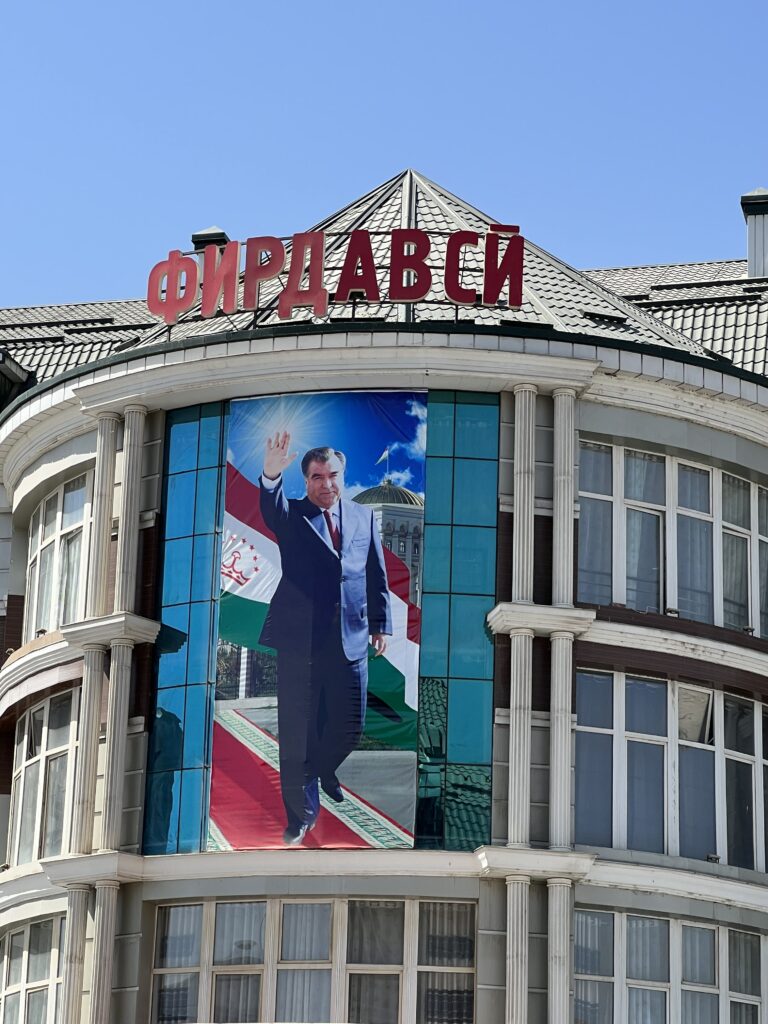
0 Comments